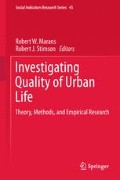Abstract
The chapter presents a case study illustrating how secondary analysis of aggregated spatial data is used to determine spatial variations in objective attributes of quality of life (QOL) across a large metro region in the USA. A set of QOUL attributes covering separate communities in the metro area are analyzed. The case study also uses longitudinal data on from previous household surveys in the metro area in weighting QOL attributes. The chapter discusses some of the methodological issues encountered in conducting this type of objective analysis including using the survey data to generate weighted aggregations of QOL attributes in order to rank communities by their overall QOL.
Access this chapter
Tax calculation will be finalised at checkout
Purchases are for personal use only
Notes
- 1.
Data from the 2001 Detroit Area Study indicate that residents throughout the metro area varied greatly in their definition of neighbourhood. About a third of the respondents described their neighborhood as their block or the clustering of houses around them, another third defined their neighborhood as anywhere from 2 to 120 blocks around them, and the remainder described their neighborhood as a square mile or more. For a description of the Detroit Area Study, see Chap. 7.
References
Arizona Department of Education (2009) School Report Cards. Retrieved from. http://www10.ade.az.gov/ReportCard/Research.aspx
Arizona Department of Public Safety (2009). Crime in Arizona (2008). Retrived from http://www.azdps.gov/About/Reports/docs/Crime_In_Arizona_Report_2008.pdf
Diener, E. (1995). A value based index for measuring national quality of life. Social Indicators Research, 36(2), 107–127.
Ellaway, A., Macintyre, S., & Kearns, A. (2001). Perceptions of place and health in socially contrasting neighbourhoods. Urban Studies, 38(12), 2299–2316.
Flowerdew, R., Manley, D. J., & Sabel, C. E. (2008). Neighbourhood effects on health: Does it matter where you draw the boundaries? Social Science and Medicine, 66(6), 1241–1255.
Frank, L. D., Andresen, M. A., & Schmid, T. L. (2004). Obesity relationships with community design, physical activity, and time spent in cars. American Journal of Preventive Medicine, 27(2), 87–96.
Haynes, R., Daras, K., Reading, R., & Jones, A. (2007). Modifiable neighbourhood units, zone design and residents’ perceptions. Health & Place, 13(4), 812–825.
Kahn, M. E. (1995). A revealed preference approach to ranking city quality of life. Journal of Urban Economics, 38(2), 221–235.
Kawachi, I., & Berkman, L. F. (2003). Neighborhoods and health (1st ed.). New York: Oxford University Press.
Lathey, V., Guhathakurta, S., & Aggarwal, R. M. (2009). The impact of subregional variations in urban sprawl on the prevalence of obesity and related morbidity. Journal of Planning Education and Research, 29(2), 127–141.
Marans, R. W., & Rodgers, W. (1975). Toward an understanding of community satisfaction. In A. H. Hawley & V. P. Rock (Eds.), Metropolitan America in community perspective (pp. 299–352). New York: Wiley.
Morris, M. D. (1979). Measuring the condition of the world’s poor: The physical quality of life index. New York: Pergamon Press. Published for the Overseas Development Council.
Morrison Institute for Public Policy (1997) What matters in greater Phoenix: Indicators of our quality of life. Tempe: Morrison Institute for Public Policy, School of Public Affairs, College of Public Programs, Arizona State University.
Morrison Institute for Public Policy (1998) What matters in greater Phoenix: Indicators of our quality of life. Tempe: Morrison Institute for Public Policy, School of Public Affairs, College of Public Programs, Arizona State University.
Morrison Institute for Public Policy (1999) What matters in greater Phoenix: Indicators of our quality of life. Tempe: Morrison Institute for Public Policy, School of Public Affairs, College of Public Programs, Arizona State University.
Morrison Institute for Public Policy (2004) What matters. Tempe: Morrison Institute for Public Policy, School of Public Affairs, College of Public Programs, Arizona State University.
Moudon, A. V., Lee, C., Cheadle, A. D., Garvin, C., Johnson, D., Schmid, T., Weathers, R. D., & Lin, L. (2006). Operational definitions of walkable neighborhood: Theoretical and empirical insights. Journal of Physical Activity and Health, 3, S99–S117.
Mukherjee, R. (1989). The quality of life: Valuation in social research. New Delhi: Sage Publications.
Openshaw, S. (1984). The modifiable areal unit problem. Norwich: Geo Books.
Perry, C. A., Heydecker, W. D., & Adams, T. (1929). Neighborhood and community planning. New York: Regional Plan of New York and Its Environs.
Roback, J. (1982). Wages, rents, and the quality of life. The Journal of Political Economy, 90(6), 1257–1278.
Rosen, S. (1979). Wage-based indexes of urban quality of life. In P. Mieszlow-ski & M. Straszheim (Eds.), Current issues in urban economics. Baltimore: John Hopkins University Press.
Sadalla, E., Guhathakurta, S., & Ledlow, S. (2005). Environment and quality of life: A conceptual analysis and review of empirical literature. In The U.S.-Mexican border environment: Dynamics of human-environment interactions (SCERP monograph series, pp. 29–79). San Diego: San Diego State University Press.
Schwartz, B. (1994). The costs of living: How market freedom erodes the best things in life. New York: W.W. Norton.
Simons, L. G., Simons, R. L., Conger, R. D., & Brody, G. H. (2004). Collective socialization and child conduct problems: A multilevel analysis with an African American sample. Youth and Society, 35(3), 267–292.
Stein, C. S. (1966). Toward new towns for America (3rd ed.). Cambridge: M.I.T. Press.
U.S. Bureau of Census (2009). American Community Survey (2005–2008). Available at hhp://factfinder.census.gov
U.S. Bureau of Census (2009). American Community Survey (2006–2008). Available at hhp://factfinder.census.gov
Author information
Authors and Affiliations
Corresponding author
Editor information
Editors and Affiliations
Rights and permissions
Copyright information
© 2011 Springer Science+Business Media B.V.
About this chapter
Cite this chapter
Guhathakurta, S., Cao, Y. (2011). Variations in Objective Quality of Urban Life Across a City Region: The Case of Phoenix. In: Marans, R., Stimson, R. (eds) Investigating Quality of Urban Life. Social Indicators Research Series, vol 45. Springer, Dordrecht. https://doi.org/10.1007/978-94-007-1742-8_6
Download citation
DOI: https://doi.org/10.1007/978-94-007-1742-8_6
Published:
Publisher Name: Springer, Dordrecht
Print ISBN: 978-94-007-1741-1
Online ISBN: 978-94-007-1742-8
eBook Packages: Humanities, Social Sciences and LawSocial Sciences (R0)

